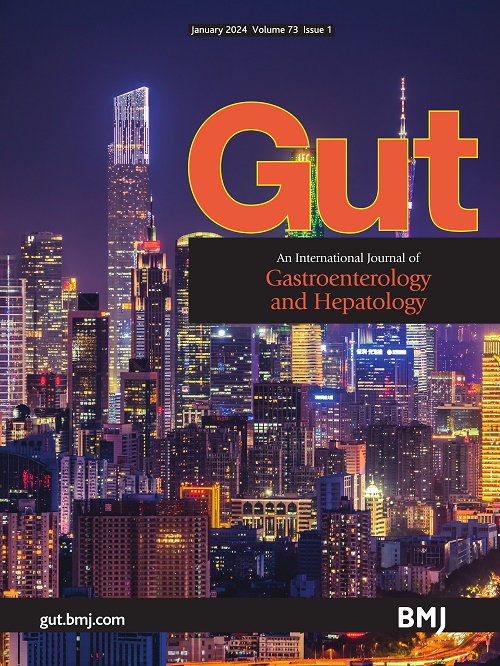阿尔茨海默病中通过迷走神经传出途径从大脑到结肠的病理性tau增殖
IF 25.8
1区 医学
Q1 GASTROENTEROLOGY & HEPATOLOGY
引用次数: 0
摘要
阿尔茨海默病(AD)是一种神经退行性疾病,其特征是淀粉样蛋白-β (a β)斑块和tau神经原纤维缠结的积累,导致认知能力下降。最近的研究强调了肠脑轴(GBA)在AD进展中的参与,表明该疾病也可能影响肠道。目的研究tau蛋白通过迷走神经从大脑传递到肠道及其对肠道功能的影响,建立一种新的体外模拟GBA的系统。我们使用AD动物模型来检查tau从大脑到结肠的扩散。我们还建立了一个神经支配的结肠芯片模型来复制GBA的关键成分,包括迷走神经运动神经元、肠神经元和结肠上皮细胞。结果在ADLPAPT小鼠中,我们观察到tau在结肠神经丛中聚集,并证实tau从海马扩散到迷走神经背运动核和结肠肠神经元。在迷走神经切除术的ADLPAPT小鼠中几乎没有观察到这种tau传递,这表明可能存在一种神经通路,通过该神经通路,tau病理可以从大脑传播到结肠。结肠芯片系统有效地模拟了这一途径,表明tau可以沿着迷走神经运动神经元传递到肠神经元,并影响结肠上皮的稳定性。结论本研究表明,tau病理可以通过迷走神经从大脑传播到结肠,为AD的脑-肠轴提供了证据。如有合理要求,可提供资料。所有与研究相关的数据都包含在文章中或作为补充信息上传。不适用。所有相关数据都包含在文章或补充文件中。本文章由计算机程序翻译,如有差异,请以英文原文为准。
Pathological tau propagation from the brain to the colon via the vagal efferent pathway in Alzheimer’s disease
Background Alzheimer’s disease (AD) is a neurodegenerative disorder marked by the accumulation of amyloid-β (Aβ) plaques and tau neurofibrillary tangles, leading to cognitive decline. Recent research has highlighted the involvement of the gut–brain axis (GBA) in AD progression, suggesting that the disease may also affect the gut. Objective To investigate the transmission of tau from the brain to the gut via the vagus nerve and its impact on gut function, we aimed to develop a novel in vitro system to simulate the GBA. Design We used an AD animal model to examine the spread of tau from the brain to the colon. We also established an innervated colon-on-a-chip model to replicate the key components of the GBA, including vagal motor neurons, enteric neurons and colon epithelial cells. Results In ADLPAPT mice, we observed tau aggregates in the nerve plexuses of the colon and confirmed that tau spreads from the hippocampus to the dorsal motor nucleus of the vagus and enteric neurons in the colon. This tau transmission was barely observed in ADLPAPT mice with vagotomy, suggesting the possibility of a neural pathway through which tau pathology can propagate from the brain to the colon. The colon-on-a-chip system effectively mimicked this pathway, showing that tau could be transmitted along the vagal motor neuron to enteric neurons and impact colon epithelium stability. Conclusions This study demonstrates that tau pathology can propagate from the brain to the colon via the vagus nerve, providing evidence supporting the brain-to-gut axis in AD. Data are available on reasonable request. All data relevant to the study are included in the article or uploaded as supplementary information. Not applicable. All relevant data are included in the article or supplementary files.
求助全文
通过发布文献求助,成功后即可免费获取论文全文。
去求助
来源期刊

Gut
医学-胃肠肝病学
CiteScore
45.70
自引率
2.40%
发文量
284
审稿时长
1.5 months
期刊介绍:
Gut is a renowned international journal specializing in gastroenterology and hepatology, known for its high-quality clinical research covering the alimentary tract, liver, biliary tree, and pancreas. It offers authoritative and current coverage across all aspects of gastroenterology and hepatology, featuring articles on emerging disease mechanisms and innovative diagnostic and therapeutic approaches authored by leading experts.
As the flagship journal of BMJ's gastroenterology portfolio, Gut is accompanied by two companion journals: Frontline Gastroenterology, focusing on education and practice-oriented papers, and BMJ Open Gastroenterology for open access original research.
 求助内容:
求助内容: 应助结果提醒方式:
应助结果提醒方式:


